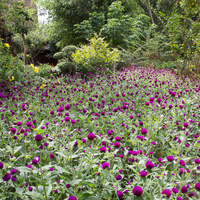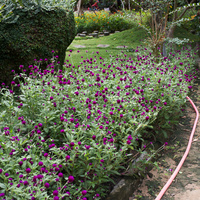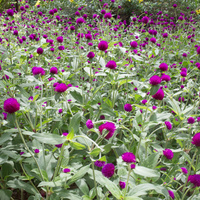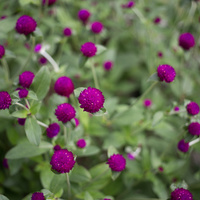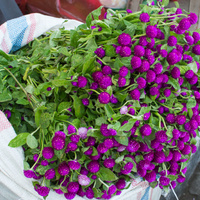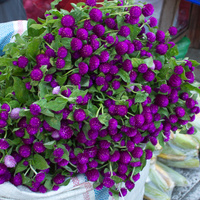Common name: Globe amaranth
Other common names: Bachelor button, Bozu, Strawberry fields
Description
Globe amaranth is a colourful flowering herb originating from tropical America but nowadays cultivated across the world in a wide range of climates.
Growing up to 80 cm (2.5 ft) tall and 30 cm (1 ft) wide, it is made-up of much-branched, soft green stems with small, pointed oblong leaves and colourful, rounded flower-heads on top. The flower-heads are no more than 2 cm (0.8 in) in diameter and either purple, pink, red, orange or white, depending on the cultivar. Their colour comes from numerous coloured bracts closely clustered, each with a tiny flower tucked away inside, and this produces a single, pin-head sized seed.
An annual herb, it grows, flowers, seeds and then dies within a year, so flowering depends on the timing of sowing and the season that follows, which in temperate and subtropical areas is late spring into summer and in tropical areas is the rainy season leading into the dry season.
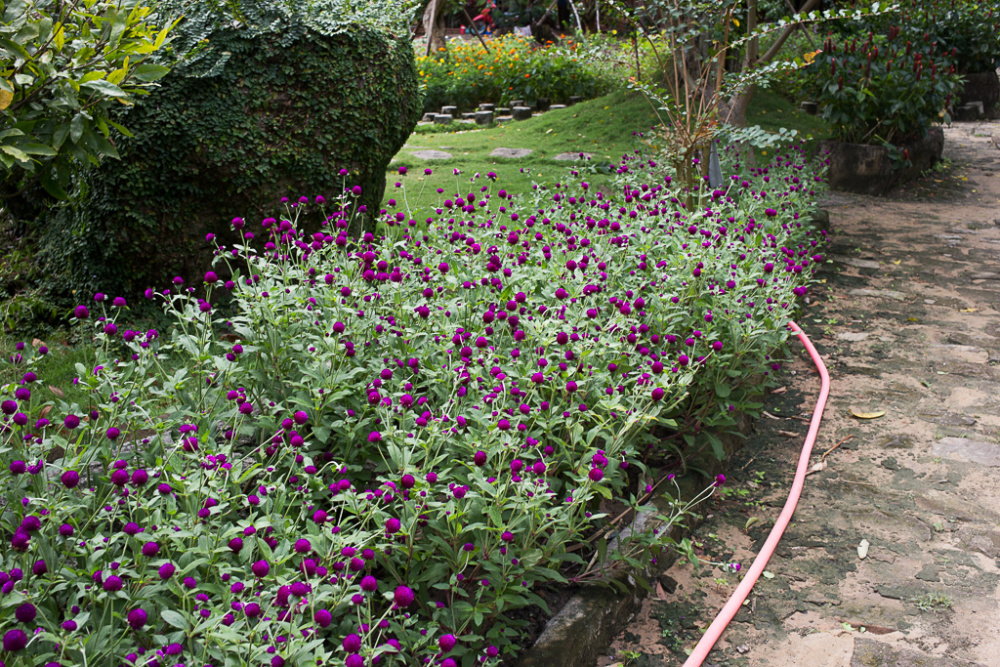
Phu Quoc Island, Vietnam
Use
Globe amaranth's compact growth and colourful flowering make it an excellent choice for garden beds and containers. And as a bonus, the tiny flowers attract butterflies.
The flower-heads are long-lasting and work well in floral arrangements. Stems for fresh-flower arrangements are cut from the plant when the flower-heads are fully coloured but not completely opened. Dark purple and red coloured varieties are preferred because they hold their colour the longest. If being stored or transported, they should be kept cool at temperatures of between 1 and 4°C (34 and 39°F). On vasing, leaves that would be submerged are stripped off and the stems stood in water with a floral preservative added. Their vase life is around five to ten days.
They also make excellent dried flowers and again the dark colours work best. For this purpose, they are best harvested when fully sized and coloured, just before they've started to fade and are hung upside-down in a dry, airy room for a few weeks.
Climate
Grows naturally as an annual in climates ranging from warm temperate to tropical, generally areas with annual lows of 6 to 25°C, annual highs of 17 to 35°C, annual rainfall of 900 to 3000 mm, and a dry season of 6 months or less, extending to 12 months with irrigation.
A heat-loving plant, Globe amaranth may not thrive in areas where the average low of the warmest month is below 11°C (52°F).
Growing
New plants are usually started from packaged seed, and these germinate more readily if soaked in water overnight. Being very small, the seed is best scattered across the top of prepared soil and lightly covered or raked in. Most should germinate with about two weeks.
Performs best on free-draining, well-manured loam, sandy-loam and loamy-sand soils of a moderately acid to neutral nature, generally with a pH of 5.0 to 7.0, and on sites with full to partial sun exposure.
Mulching is essential to maintain soil moisture during dry weather, but the plants should not be over-watered, as this encourages fungal disease.
Problem features
Globe Amaranth is recorded as having escaped cultivation in Australia and has been assessed as a high weed risk species for Hawaii, by the Hawaii Pacific Weed Risk Assessment (HPWRA) project. It was not, however, found to be a high weed risk for Florida, under the Assessment of Non-Native Plants in Florida's Natural Areas (IFAS).
Where it grows
References
Books
-
Adams, C. D. 1972, Flowering plants of Jamaica, University of the West Indies, Mona, Greater Kingston
-
Cassidy, F. G. & Le Page, R. B. 1980, Dictionary of Jamaican English, 2nd ed., Cambridge University Press, Cambridgeshire
-
Editors of Sunset Magazine 2012, The New Western Garden Book: The Ultimate Gardening Guide, 9th edition, Sunset Publishing Corporation, California
-
Hunter, N. T & Mitchell, H. 1994, The art of floral design, Delmar Publishers, Albany, New York
-
Jones, R. 2001, Caring for cut flowers, 2nd ed, Landlinks Press, Victoria, Australia
-
Mackey, B. & Brandies, M. M., 2001, A cutting garden for Florida : grow marvelous flowers for bouquets in your Florida home landscape, 3rd edition, revised and expanded, B.B. Mackey Books, Wayne, Pennsylvania
-
Macmillan, H. F. 1943, Tropical planting and gardening : with special reference to Ceylon, 5th ed, Macmillan Publishing, London
-
Randall, R. P. 2002, A global compendium of weeds, R.G. and F.J. Richardson Press, Melbourne
-
Randall, R. P. 2007, The introduced flora of Australia and its weed status, Cooperative Research Centre for Australian Weed Management, Glen Osmond, South Australia
-
Staples, G. & Herbst, D. R. 2005, A tropical garden flora : plants cultivated in the Hawaiian Islands and other tropical places, Bishop Museum Press, Honolulu, Hawaii
